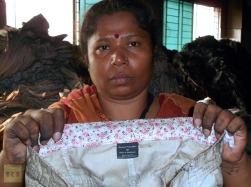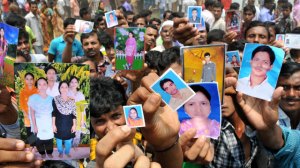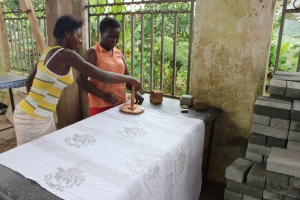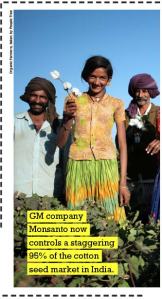
On April 24, 2013, the Rana Plaza in Savar, Bangladesh collapsed, killing more than a 1,000 people and injuring more than 2,500.
On the evening of April 23, 2013, garment factory employees of the Rana Plaza building in Savar, Bangladesh, pleaded with management to take notice of the sudden cracks that had appeared in the walls and foundations. Their requests for evacuation were ignored on the basis that the building owner, Sohel Rana, had just hired an engineer who had pronounced the building safe. The mostly female labor force, who were threatened with losing a month’s pay if they did not return, were ordered to work the next day. As they arrived at the building, the first thing they heard over the loudspeaker was this: “All the workers of Rana Plaza, go to work. The factory has already been repaired.” Just half an hour later, the eight-story building collapsed, killing over 1,000 people and injuring more than 2,500. Local workers and relatives were some of the first on the scene, digging out mutilated bodies, including those of children who had been staying at the building’s day care center, from the rubble.

Never again. Two victims hold each other amid the rubble of the Rana Plaza collapse (photo courtesy of Taslima Akhter).
And then, there was that picture. That haunting image of two people clinging to each other for survival, with their lower parts of their bodies buried under concrete and a tear of blood running down the man’s cheek. This photo served as a harsh reminder of what happens when we treat humans as just numbers, or as simply ‘cheap labor’ within a global supply chain that feeds the consumption patterns of the United States and European Union by delivering low-cost clothing from Bangladeshi factories to stores in the West. It is an industry that operates according to a logic of distance, in which a consumer is so removed from the condition under which a producer labors that they are less likely to have awareness, let alone any motivation to protest. The consumer was suddenly forced to get close and personal as people around the globe were confronted with the image of that heartbreaking final embrace.
Deemed the worst garment factory disaster in history, it implicated not just the lax regulations of the Bangladeshi garment industry, but companies such as Wal-Mart, The Children’s Place, H&M, Mango, Primark, Joe Fresh, and Benetton which used Bangladesh as a source of cheap labor. There were of course initial attempts to deny responsibility, with Wal-Mart claiming that they never contracted with the factory, and Finance Minister Abul Maal Abdul Muhith dismissing the collapse as “not really serious” and, an “accident.”

‘Accidents’ don’t happen again..and again. Bangladeshi Army personnel walks through the rows of burnt sewing machines in the aftermath of the Tazreen factory fire, which killed at least 117 people in November, 2012 (photo courtesty of Stringer/AFP/Getty Images).
The factory collapse of Rana was not an accident, as various government officials, corporations, and even certain media outlets have described it. An accident is something that is unexpected, that occurs infrequently, but also is something that is not necessarily preventable. This tragedy was not an isolated event. It was, in fact, one of several hundred other factory incidents that have killed over 1,000 workers from 1990 to 2012 in Bangladesh, a country that employs four million garment workers, 85 percent of whom are women, in its growing garment industry. And, like the dozens of other factory fires that have been reported across the industry in countries like China, India, and Pakistan, it could have been prevented with proper safety measures and a workplace in which factory managers listened to workers’ concerns.

Garment workers in Bangladesh, 85% of whom are women, are paid $37 a month…far below the living wage of $120 that is needed to survive. Unions, which can give workers a collective voice, are all but outlawed (photo courtesy of Reuters).
Ultimately, these deadly fires only reveal the exploitative working conditions of an industry that treats its workers as disposable items. In Bangladesh, a country rich with culture and natural resources but ridden with poverty, the government has long viewed the garment industry as the path to improving a grim standard of living. Currently garments represent nearly 80 percent of the country’s manufacturing export income of $19.1 billion between 2011-2012, making it the second largest exporter of apparel in the world. Yet despite the industry’s rapid growth in the last thirty years, Bangladeshi workers are still the lowest paid garment workers in the world, earning a minimum of $37 a month – far below the living wage of $120 that is needed for basic household necessities. Workers’ efforts to organize for better pay and safety regulations are all but outlawed, and a new labor law that was passed in July has been criticized by labor advocates as actually weakening, rather than strengthening, protections for workers.

In Bangladesh, factory owners are often entrenched in the political elite. Due to global outrage after the Rana Plaza fire, factory owner Sohel Rana was arrested (photo courtesy of AP).
This isn’t surprising, given that Bangladesh’s legal system has remained largely unchanged from the British imperial era, in which laws were designed to uphold the colonialist power structure and control the population. In fact, many factory owners and members of the Bangladesh Garment Manufacturers and Exporters Association (BGMEA) are heavily involved in the political elite, often holding government positions that allow them to wield enormous political influence. Given the tremendous emphasis on maximizing wealth in the global economy, it is thus not surprising that governments of poorer countries like Bangladesh often sacrifice human rights at the consummate altar of economic ‘development.’

Bangladeshi labor activist Kalpona Akter found Wal-Mart brands such as Faded Glory in the remains of the Tazreen factory fire. Brands place immense pressure on factories to produce cheap clothing on short deadlines (photo courtesy of AFP).
At the same time, the Bangladesh government may feel trapped when companies such as Wal-Mart and other big retailers place immense pressure on factories to produce forever falling prices by selling cheap and producing quickly on shorter deadlines. Low prices in the garment industry are, after all, the country’s best selling point in the global economy. So suppliers cut their prices at the expense of their workers, who are paid poverty wages and made to work excessive hours. Factory owners, squeezed by their buyers, often find their efforts to invest in factory safety undermined by the pressure to reduce costs.
Companies in turn claim that social auditing programs are an effective way to monitor working conditions in their factories, but these programs have been criticized as corporate-funded, voluntary, and a public relations cover. Who can forget the massive factory fire in Pakistan that killed more than 260 workers last year, which just three weeks before, had been granted certification by the social auditing group, Social Accountability International. Of course, companies could have saved lives by releasing their audit findings to the government and sharing them with Bangladeshi unions and labor rights groups, but they are under no obligation to do that given that these audits are confidential and are treated as their own private intellectual property. Instead, workers’ input is rarely taken into consideration, and those who do dare to complain are often harassed or even terminated.
As Mafusa, a survivor of the Tazreen factory fire in Dhaka, Bangladesh that killed at least 112 people last November, revealed:
“We never got our salary on time. We were always informed one day before foreigners came for an audit. We had to clean, make everything neat and we were given instructions about what we had to say like that we get our salary always on the seventh of the month and about our working hours.”
To make matters worse, the global demand for cheap clothing forces many factories to subcontract their work to other suppliers, making it difficult for brands to trace who is making their clothes in an increasingly complex supply chain.
The ever increasing global demand has led to another flagrant human rights violation. Although child labor is illegal, recent reports have revealed the use of children as young as nine working in many of these factories. This reliance on child labor is the devastating consequence of not paying adults a living wage. Yet, instead of investing in workers’ rights and safety upgrades, apparel consumer companies will often choose to run from these factories once they learn that unauthorized work was used to produce their clothing, as Wal-Mart did after the Tazreen factory fire in Bangladesh.
Toronto Star Reporter Raveena Aulakh works undercover in a Bangladesh garment factory with a nine year old girl as her boss:
Several years ago, Nicholas Kristof wrote a now controversial piece arguing against the ‘anti-sweatshop’ movement, claiming that for many workers, sweatshops were the only viable option for making a living. He argued for labor advocates to fight for more sweatshops as the best option for workers in the Global South. In Bangladesh, women do indeed come to the cities from the rural areas to work in factories after fleeing environmental destruction and repressive family structures in their home villages. Yet, does that mean they should be forced to endure harassment and abuse from their predominantly male bosses? Or rely on precarious employment in which they are often paid less than their male counterparts, despite being the sole or primary breadwinners in their families? Shouldn’t they have a right to a workplace that doesn’t push their bodies to the point of exhaustion, that doesn’t fire them once they get pregnant, and that gives them a voice and treats them with a measure of dignity?

A Bangladesh factory that sews garments for The Gap and Old Navy was implicated in abusing their pregnant workers. Morium Begum, shown here with her husband Golzar, lost her baby after being forced to work 100 hours a week (photo courtesy of thestar.com).
Kristof may have been well-meaning, but his argument didn’t address the true intent of the anti-sweatshop movement, which is to progress the cause of workers’ rights and advocate for living wages by pressuring multinational corporations to improve factory conditions. The international climate is starting to change as people wake up to the fact that they shouldn’t put clothes on their back that were made in conditions that have not been seen in the West since the Industrial Revolution. Currently, over 100 apparel brands and retailers in Europe, North America, Asia, and Australia have signed the Accord on Fire and Building Safety in Bangladesh, an unprecedented legally-binding agreement that was created by Bangladeshi and global trade unions in alliance with leading NGOs and the International Labor Organization (ILO) to ensure safety in Bangladeshi factories. This five-year contract will require independent safety inspections of their facilities, public reporting, safety upgrades financed by brands, the integration of workers and unions in both oversight and implementation, and higher wages.

“There’s an abundance of wealth in the industry, so why can’t we have fair treatment for workers?” – Sarah Ziff, model who protested with Bangladesh activists at Nautica’s Spring 2014 show.
The Accord has been hailed as a transformative move away from the corporate-controlled social auditing programs that rely on largely “voluntary, confidential, and top-down” initiatives. It has also been supported broadly, with senators, students, and fashion models protesting brands that have failed to commit to the agreement. And just recently, the Accord publicly disclosed information about the building safety of the 1,600 factories covered by the pact, bringing a measure of openness, transparency and accountability to an industry that has been shrouded in secrets.

A safety effort proposed by North American retailers has been criticized for not being legally binding (photo courtesy of Inhabitat).
While notable (mostly European) companies such as H&M, Inditex (Zara), and Primark have signed the Accord, there are still a number of North American retailers that have been unwilling to join the agreement. U.S. industry leaders such as Gap and Wal-Mart launched the Bangladesh Worker Safety Initiative in July, a comparatively weak agreement that promises safety upgrades, a hotline to report complaints, and regular inspections without any legal commitment. The need for a legally binding agreement is even more pressing when considering that the $42 million raised by the companies involved in the initiative to improve factory infrastructure is paltry compared to the actual estimated cost of necessary improvements, which is $300,000 to $500,000 per factory. The companies that reject the accord cite concerns that the provision for legal enforcement through arbitration makes them more ‘vulnerable’ to class-action suits. But two law professors writing for the Los Angeles Times disputed this claim, stating that the only legal liability for signatories would be to abide by its terms. They further argue that in fact, Gap and Wal-Mart sign legally enforceable agreements all the time in their global business dealings, and that their reluctance to join the Accord stems from its purpose, which would be to help protect worker’s rights rather than simply facilitate the buying and selling of apparel for corporate profit. As they put it, “underlying the American firms’ objections, it appears, is the fear of both financial and moral responsibility.”

Relatives of Rana Plaza victims demand compensation from Wal-Mart, which along with other U.S. retailers such as Gap, Sears, and Children’s Place, have refused to pay compensation (photo courtesy of Abir Abdullah/EPA).
Even more distressing is that very few companies have initiated concrete proposals to secure compensation for the victims of either the Tazreen or Rana Plaza factory fires. The UN Guidelines on Business and Human Rights dictates that companies must go beyond simply defending human rights and actually take action in remedying these tragedies. And an internationally-recognized formula that has been implemented in compensation plans after numerous other building safety incidents and fires has determined that brands and retailers are the most accountable for the failings that led to the disasters. Companies that had a direct or indirect relationship with the Rana Plaza factory or Tazreen are thus responsible for paying a full and fair compensation to the wounded workers and the families of those who were killed, so that they can access the medical care they need and continue to help support their families. This is especially important in Bangladesh, where the lack of a safety net such as social security, unemployment, or medical aid exacerbates the poverty wages and miserable living conditions for workers. Just recently in September, the Rana Plaza Compensation Coordination Committee consisting of various apparel brands, the Bangladesh government, local and global trade unions and NGOs, met to develop a mechanism dubbed the “Arrangement” by which compensation for the families of the disaster could be determined. Although some progress has been made, with brands like Loblaw and Primark just recently committing to long-term relief, far too many have failed to join the Arrangement, leaving workers with little hope for palpable improvement in their dismal conditions.
As Liana Foxvog of the International Labor Rights Forum (ILRF) stressed,
“When global apparel brands establish factory inspection programs that are confidential and voluntary, they communicate to Bangladeshi managers that they see no reason for workers to be informed of workplace risks. When global brands create programs that circumvent union initiatives – as many of the North American brands that have created the Alliance for Bangladesh Worker Safety are doing – they perpetuate the understanding within Bangladesh that solutions do not require workers’ having an independent voice and an equal place at the bargaining table. And when global brands don’t participate in the compensation for victims, they signal to Bangladesh’s leaders that it is okay to put workers lives at risk and walk away from the consequence.”
The time is now for multinational corporations to stop hiding behind deceptive and dishonest corporate social responsibility schemes that rely on corporate-sponsored monitoring and ‘codes of conduct’ plastered on their websites to mask worker abuse in their supply chains. If Gap Inc. is truly ‘committed’ to Bangladesh worker safety as they state on their CSR page, then why haven’t they made a commitment to renovate one factory? Why did they violate their own codes of conduct by sourcing out to a factory in which their workers are forced to labor over 100 hours a week and some pregnant women are illegally fired and denied paid maternity leave? If U.S. retailer Children’s Place is “deeply saddened” by the Rana Plaza factory fire, then why have they not agreed to compensate the victims, many of whom are orphans who lost their parents in the fire? Shouldn’t a clothing line that caters to children feel a certain degree of responsibility to the children on the other side of the supply chain?

Retailer Children’s Place refuses to pay compensation to the orphans left behind after the Rana Plaza fire (photo courtesy of orphansplace.com).
These tragedies have ultimately implicated Western buyers as complicit in the apparel industry’s dark side. However, contrary to what Nicholas Kristof and others may believe, what labor rights organizations are advocating for is not an end to this relationship between brands and the countries from which they source. In fact, the hope here is that by deepening their engagement, these companies could be the best hope for transformative change in the industry. As Kalpona Akter, executive director of the Bangladesh Center for Worker Solidarity stressed in a recent interview with The Nation:
“If consumers stop buying, that is like a boycott and a boycott doesn’t help us. Instead, we want people to write letters to Walmart, talk to their communities and friends about what is happening, raise their voice and protest at the stores with their physical presence. We want US consumers to say, “‘We’re watching you and we demand that you pay attention.'”
This is an appeal for all the apparel companies sourcing out of Bangladesh to not just join the Accord but to contribute to the process of compensation for the victims and their families, so that the nearly four million women who make our clothes can get a sustainable living wage and be treated with dignity. Furthermore, there needs to be a sustained conversation from brands about how to change the industry that goes beyond just apologies and knee-jerk CSR responses. In an industry where labor costs represent one to three percent of the retail price, the validity of a living wage needs to be on the table. Since, adjusting for inflation, clothing is far less expensive now than it was fifty years ago, prices need to be adjusted. Most importantly, companies need to invest in a long-term commitment with their factories instead of leaving when something goes wrong. Brands like WalMart need to acknowledge when they have lost control over their supply chain instead of displacing blame onto others.

(photo courtesy of justmeans.com).
Finally, the media and consumers need to make a continuous and consistent call for change in the industry, so that the victims of these tragedies are not dismissed as merely collateral damage in an ‘unfortunate accident,’ but as fellow human beings who live, breathe, have children and go to work. Seeing, after all, isn’t always believing. Sometime we have to believe, so that we can see.
Take Action:
Tweet! Want to take part in a twitter campaign to pressure retailers like Walmart, Children’s Place, The Gap, and Sears to sign the Accord and pay compensation to victims’ families? Here are some examples you can use:
- 1 year after fire kills 117,
@Walmart STILL owes compensation to victims. Pay up now! http://on.fb.me/1j9RtkX#EndDeathtraps - 8 months after fire kills 1,129,
@childrensplace STILL owes compensation to orphans. Pay now! http://orphansplace.com/#EndDeathtraps - 8 months after Rana fire kills 1,129,
@gap STILL hasn’t committed to compensating victims. Pay now! http://gapdeathtraps.com/#EndDeathtraps - My holiday wish is for @ChildrensPlace to pay compensation to Rana Plaza disaster victims: http://nyti.ms/1cSiZTN #EndDeathtraps
- Why not tweet to these retailers who signed the Accord and thank them? Let H&M know you like that they’re considering a living wage for workers!
Sign a petition! Demand that retailers end deathtraps and pay compensation to victims and their families. Here are the links for petitions to Gap, Wal-Mart, and The Children’s Place.
Share: Both of these videos (here and here) interviewing survivors of the Rana Plaza fire are a must-watch.
Get involved! Check out United Students Against Sweatshops campaign to get universities to sign the Accord on Fire and Building Safety. They have already had a few victories! Also check out the Bangladesh Center for Worker Solidarity, the Clean Clothes Campaign, International Labor Rights Forum, Jobs with Justice, United with Respect, and SumOfUs.
Get inspired: Read about Cambodian factory workers winning a settlement against Wal-Mart, how workers defied Wal-Mart this holiday season, and how university students successfully pressured Adidas to sign the Bangladesh Accord!
Want to learn how an apparel factory in the Dominican Republic is making a profit while paying its workers a living wage? Stay tuned for an upcoming post on this amazing company!
My Related Posts:
- Ethical Fashion: Introduction to an Ongoing Series
- “The True Cost”: A Documentary on the Global Fashion Industry’s Impact
- Ethical Fashion: How to Navigate the Industry
- The Chocolate Industry Exposed: Child Labor, Trafficking, and Fair Trade Mislabeling
- New York Fashion Week – the Fantasy and the Fire












